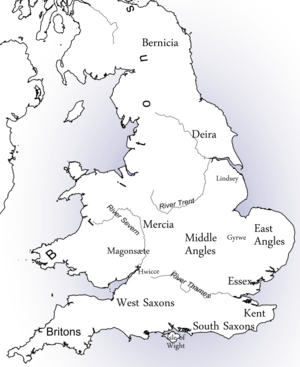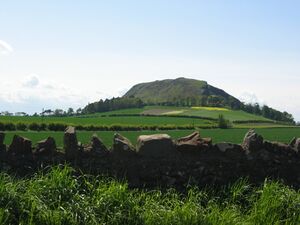Lothian
Lothian is referred to a province encompassing most of what is now southeastern Scotland. The name is said to be given by King Lot, who chiefly figures as king of Lothian, but in other sources he also rules Orkney and sometimes Norway.
Contents
Variants of name
- Lothian (/ˈloʊðiən/; Scots: Lowden;[1]
- Lothians
- Lodainn (Scottish Gaelic: [ˈɫ̪ot̪aɲ])
- Laudonia (Latin form)
- Lugudūniānā
Location
The Lothian region of the Scottish Lowlands, lying between the southern shore of the Firth of Forth and the Lammermuir Hills. The principal settlement is the Scottish capital, Edinburgh, while other significant towns include Livingston, Linlithgow, Queensferry, Dalkeith, Musselburgh, Prestonpans, North Berwick, Dunbar, and Haddington.
Jat clan
Etymology
The origin of the name is debated. It perhaps comes from the British *Lugudūniānā (Lleuddiniawn in Modern Welsh spelling) meaning "country of the fort of Lugus", the latter being a Celtic god of commerce.[2] Alternatively it may take its name from a watercourse which flows through the region, now known as the Lothian Burn,[3] the name of which comes from the British lutna meaning "dark or muddy stream".[4][5]
A popular legend is that the name comes from King Lot, who is king of Lothian in the Arthurian legend. The usual Latin form of the name is Laudonia.[6]
King Lot
Lot or Loth /ˈlɒt/ is the king of Lothian in the Arthurian legend. He is best known as the father of Sir Gawain. Such a ruler first appeared late in the 1st millennium's hagiographical material concerning Saint Kentigern (also known as Saint Mungo), which feature a Leudonus, king of Leudonia, a Latin name for Lothian. In the 12th century, Geoffrey of Monmouth adapted this to Lot, king of Lothian, in his influential chronicle Historia Regum Britanniae, portraying him as King Arthur's brother-in-law and ally. In the wake of Geoffrey's writings, Lot appeared regularly in later romance.
Lot chiefly figures as king of Lothian, but in other sources he also rules Orkney and sometimes Norway. He is generally depicted as the husband of Arthur's sister or half-sister, variously named Anna or Morgause. The names and number of his children vary depending on the source, but the later romance tradition gives him the sons Gawain, Agravain, Gaheris, Gareth, and Mordred.
Early literature:
A king of Lothian appears in both early Latin and Welsh sources. An early fragmentary Life of St Kentigern contains a Leudonus of Leudonia as the maternal grandfather of Saint Kentigern, also known as Mungo.[7] In this text, Leudonus becomes enraged when he discovers that his daughter, Kentigern's mother Teneu, had been raped and become pregnant by Owain mab Urien, and has her thrown from a cliff. However, she survives the ordeal with divine protection and goes to Saint Serf's community, where she gives birth to Kentigern.
Welsh sources call this same character Lewdwn or Llewdwn Lluydauc (Llewdwn of the Hosts) and make him king of Gododdin. Geoffrey of Monmouth seems to recall this earlier figure in the king whom he called Lot or Loth in his Historia Regum Britanniae. His sources are obscure, but his choice of name is probably based on its similarity to "Lodonesia", a typical Latinized name for Lothian.[8] This toponymical connection parallels Geoffrey's association of King Leir with Leicester and Coel with Colchester, and William of Malmesbury's assertion that Gawain was king of Galloway. In the Middle Ages, no principle of historiography was more solidly established than the idea that places took their names from persons.[9]
Geoffrey's Lot is one of three brothers, each of whom rules a part of northern Britain: Lot rules Lodonesia or Lothian, while his brothers Urien (the father of Owain, both generally reckoned historical kings of Rheged) and Angusel rule over Mureif (Moray) and "Scotland", respectively.[10] Lot is first mentioned as a loyal vassal to Uther Pendragon, King of Britain, in the king's wars against Octa, the Saxon King of Kent. When Uther falls ill, he marries his daughter Anna to Lot and entrusts them with the oversight of the kingdom.[11] Lot and Anna have sons Gawain and Mordred. When Uther's son Arthur takes up the kingship, he helps Lot and his brothers regain their territories, which have fallen to the Saxons.[12] Lot is also the heir to the kingdom of Norway, as nephew to the previous king Sichelm. With Arthur's aid, he takes the kingdom from the usurper Riculf.[13] Lot later leads one of Arthur's armies in his war against Emperor Lucius of Rome.[14]
The name Lot may be connected to the Norse name Hlot or Ljot, which appears in the Norse sagas and was known in Orkney. It may also be connected to the standing stone called the Stone Lud.[15]
History
Historically, the term Lothian referred to a province encompassing most of what is now southeastern Scotland. In the 7th century it came under the control of the Anglian kingdom of Bernicia, the northern part of the later kingdom of Northumbria, but the Angles' grip on Lothian was quickly weakened following the Battle of Nechtansmere in which they were defeated by the Picts. Lothian was annexed to the Kingdom of Scotland around the 10th century.[16]
Subsequent Scottish history saw the region subdivided into three shires—Mid, East, and West Lothian—leading to the popular designation of "the Lothians".
Lothian under the control of the Angles
Lothian was settled by Angles at an early stage and formed part of the Kingdom of Bernicia, which extended south into present-day Northumberland. Many place names in the Lothians and Scottish Borders demonstrate that the English language became firmly established in the region from the sixth century onwards. In due course Bernicia united with Deira to form the Kingdom of Northumbria. Important Anglo Saxon structural remains have been found in Aberlady along with various artefacts such as an early 9th century Anglo Saxon coin.[17]
Little is recorded of Lothian's history specifically in this time. After the Norse settled in what is now Yorkshire, Northumbria was effectively cut in two. How much Norse influence spread to the English north of the River Tees is uncertain. Bernicia continued as a distinct territory, sometimes described as having a king, at other times an ealdorman (earl). Bernicia became distinct from other English territories at this time due to its links with the other Christian kingdoms in what is present-day Scotland and seems to have little to do with the Norse-controlled areas to the south. Roger of Wendover wrote that Edgar, King of the English granted Laudian to the King of Scots in 973 on condition that he come to court whenever the English king or his successors wore his crown. It is widely accepted by medieval historians that this marks the point at which Lothian came under Scottish control. The River Tweed became the de facto Anglo-Scottish border following the Battle of Carham in 1018.
William the Conqueror invaded Lothian and crossed over the River Forth[18] but did not re-annex it. At this time Lothian appears in the Anglo-Saxon Chronicle as Loðen or Loþen. As late as 1091, the Chronicle describes how the Scottish king, Malcolm, "went with his army out of Scotland into Lothian", and in the reign of King David, the people living in Lothian are described as "English" subjects of the king.
External links
References
- ↑ "Dictionary of the Scots Language :: SND :: Lowden prop. n". Dsl.ac.uk.
- ↑ Koch, John, Celtic Culture, ABC-CLIO, 2006, p. 1191.
- ↑ Also known as the Burdiehouse, Niddrie, or Brunstane Burn as it passes through those neighbourhoods.
- ↑ In contrast to the nearby Peffer Burn, the name of which comes from pefr, 'clear stream'.
- ↑ Harris, Stuart (2002). The Place Names of Edinburgh: their Origins and History. London & Edinburgh: Steve Savage Publishers Ltd. ISBN 1904246060.
- ↑ Harris, Stuart (2002). The Place Names of Edinburgh: their Origins and History. London & Edinburgh: Steve Savage Publishers Ltd. ISBN 1904246060.
- ↑ Bromwich, Rachel (2006). Trioedd Ynys Prydein: The Triads of the Island of Britain. University Of Wales Press. ISBN 0-7083-1386-8.p.424-415
- ↑ Bromwich, pp. 414–415.
- ↑ R. S. Loomis, Scotland and the Arthurian Legend.
- ↑ Historia Regum Britanniae, Book 9, ch. 9.
- ↑ Historia Regum Britanniae, Book 8, ch. 21.
- ↑ Historia Regum Britanniae, Book 9, ch. 9.
- ↑ Historia Regum Britanniae, Book 9, ch. 11.
- ↑ Historia Regum Britanniae, Book 10, ch. 6.
- ↑ Leslie J. Myatt, The Standing Stones of Caithness, 2003
- ↑ "Ancient Lothian Timeline". Cyberscotia.net.
- ↑ "Important Anglo Saxon remains discovered in East Lothian". www.historyscotland.com.
- ↑ Anglo-Saxon Chronicle

